
- Geography India - Introduction
- Geography India - Physical Aspect
- Geography India - Drainage System
- Geography India - Climate
- Geography India - Natural Vegetation
- Geography India - National Forest
- Geography India - Wildlife
- Geography India - Soil
- Geography India - Land Resources
- Geography India - Agriculture
- Geography India - Mineral Resources
- Geography India - Energy Resources
- Geography India - Industry
- Geography India - Transport
- Geography India - Communication
- Geography India - Foreign Trade
- Geography India - The People
- Geography India - Settlement
- Geography India - Migration
- Regional Development
- Geography India - Disasters
- Geography of the World
- Geography World - Introduction
- Evolution of the Earth
- Geography World - Climate
- Geography World - Transport
- Geography World - Communications
- Geography World - Population
- Human Settlement
- Human Development
- International Trade
- Geography Useful Resources
- Geography - Online Quiz
- Geography - Online Test
- Geography - Quick Guide
- Geography - Useful Resources
- Geography - Discussion
Geography India - Agriculture
Introduction
There are three distinct cropping seasons in the northern and interior parts of India, namely kharif, rabi, and zaid.
| Cropping Season | Major Crops Cultivated | |
|---|---|---|
| Northern States | Southern States | |
| Kharif (June-September) | Rice, Cotton, Bajra, Maize, Jowar, Toor | Rice, Maize, Ragi, Jowar, Groundnut |
| Rabi (October March) | Wheat, Gram, Rapeseeds, and Mustard, Barley | Rice, Maize, Ragi, Groundnut, Jowar |
| Zaid (AprilJune) | Vegetables, Fruits, Fodder | Rice, Vegetables, Fodder |
Dryland farming is largely restricted to the regions having annual rainfall less than 75 cm. Major crops are ragi, bajra, moong, gram, and guar (fodder crops).
The regions, which have rainfall in excess of soil moisture requirement of plants during the rainy season is known as wetland farming. Major crops are rice, jute, and sugarcane.
The cereals occupy about 54% of total cropped area in India.
India produces about 11% cereals of the world and ranks 3rd in production after China and U.S.A.
Indian cereals are classified as fine grains (e.g. rice, wheat, etc.) and coarse grains (e.g. jowar, bajra, maize, ragi, etc.).
Types of Farming
On the basis of main source of moisture for crops, the farming can be classified as irrigated and rainfed.
On the basis of adequacy of soil moisture during cropping season, rainfed farming is further classified as dryland and wetland farming.
Major Crops
In southern states and West Bengal, the climatic conditions facilitate the cultivation of two or three crops of rice in an agricultural year.
In West Bengal farmers grow three crops of rice called aus, aman, and boro.
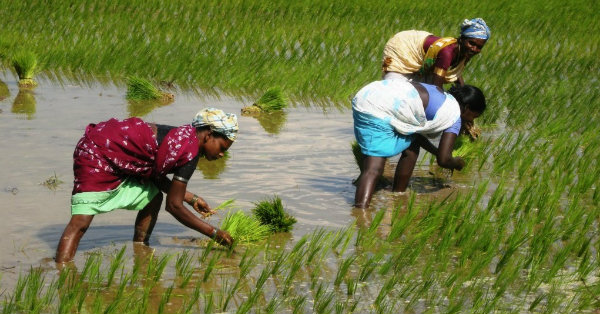
India contributes more than 20% to worlds rice production and ranks 2nd after China.
About one-fourth of the total cropped area of India is under rice cultivation.
West Bengal, Punjab, and Uttar Pradesh are the leading rice producing states.
India produces about 12% of total wheat production of the world.
About 85% of total area under this crop is concentrated in north and central regions of the country, i.e., the Indo-Gangetic Plain, Malwa Plateau, and the Himalayan regions especially up to 2,700 m altitude.
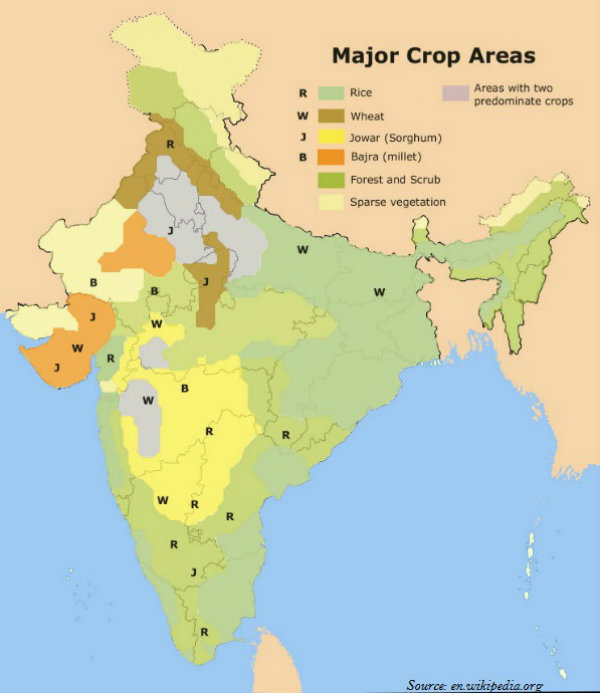
About 14% of the total cropped area in the country is under wheat cultivation.
Uttar Pradesh, Punjab, Haryana, Rajasthan, and Madhya Pradesh are wheat producing states.
The coarse cereals together occupy about 16.50% of total cropped area in the country.
Maharashtra alone contributes to more than half of the total jowar production of the country.
Bajra occupies about 5.2% of total cropped area in the country.
Maharashtra, Gujarat, Uttar Pradesh, Rajasthan, and Haryana are the leading Bajra producer states.
Maize is a food as well as fodder crop grown under the semi-arid climatic conditions and over inferior soils.
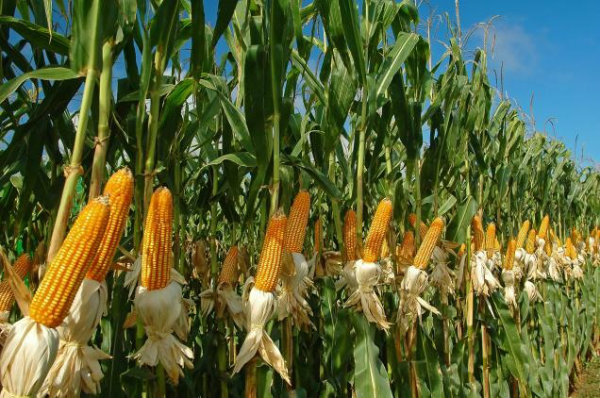
Maize occupies about 3.6% of the total cropped area of India.
Madhya Pradesh, Andhra Pradesh, Telangana, Karnataka, Rajasthan, and Uttar Pradesh are the leading maize producers in the country.
Pulses are the legume crops, which increase the natural fertility of soils through nitrogen fixation.
With one-fifth of the total production of pulses in the world, India is a leading producer.
Pulses occupy about 11% of the total cropped area in the country.
The cultivation of pulses in the country is largely concentrated in the drylands of Deccan and central plateaus and northwestern parts.
Gram and Toor are the main pulses cultivated in India.
Gram covers only about 2.8% of the total cropped area in the country.
Madhya Pradesh, Uttar Pradesh, Maharashtra, Andhra Pradesh, Telangana, and Rajasthan are the main producers of gram.
Toor (Arhar) is also known as red gram or pigeon pea.
Toor occupies only about 2% of total cropped area of India.
Maharashtra alone contributes to about one-third of the total production of toor.
Groundnut, rapeseed and mustard, soyabean, and sunflower are the main oilseed crops grown in India.
Oilseeds occupy about 14% of total cropped area in the country.
Drylands of Malwa plateau, Marathwada, Gujarat, Rajasthan, Telangana, Rayalseema region of Andhra Pradesh and Karnataka plateau are the major oilseeds growing regions of India.
India produces about 18.8% of the total groundnut production in the world.
Groundnut covers about 3.6% of total cropped area in the country.
Gujarat, Tamil Nadu, Telangana, Andhra Pradesh, Karnataka, and Maharashtra are the leading groundnut producer states in India.
Rapeseed and mustard comprise several oilseeds such as rai, sarson, toria, and taramira.
Rapeseed and mustard oilseeds together occupy only 2.5% of total cropped area in the country.
Rajasthan alone contributes to about one-third production (of oilseeds) while Uttar Pradesh, Haryana, West Bengal, and Madhya Pradesh other leading producers.
Sunflower cultivation is concentrated in the regions of Karnataka, Andhra Pradesh, Telangana, and adjoining areas of Maharashtra.
India grows both the short staple (Indian) cotton as well as the long staple (American) cotton called narma in north-western parts of the country.
India accounts to about 8.3% of worlds total production of cotton.
India ranks $4^{th}$ in the world for production of cotton after China, U.S.A., and Pakistan.
Cotton occupies about 4.7% of total cropped area in the country.
The major cotton growing areas in India are parts of Punjab, Haryana, and northern Rajasthan in the north-west; Gujarat and Maharashtra in the west; and plateaus of Andhra Pradesh, Karnataka, and Tamil Nadu in the south.
Maharashtra, Gujarat, Andhra Pradesh, Punjab, and Haryana are the leading cotton producing states.
India produces about three-fifth of the total jute production of the world.
West Bengal contributes about three-fourth of the total production of jute in the country.
India is the second largest producer of sugarcane after Brazil.
Sugarcane occupies 2.4% of total cropped area in the country and contributes about 23% to the worlds production of sugarcane.
Uttar Pradesh produces about two-fifth of sugarcane of the country; other leading producers are Maharashtra, Karnataka, Tamil Nadu, Telangana, and Andhra Pradesh.
Tea is a plantation crop and used as a major beverage in India.
Black tea leaves are fermented whereas green tea leaves are not fermented.
Tea leaves have rich content of caffeine and tannin.
Tea is grown over the undulating topography of hilly areas and well drained soils in humid and sub-humid tropics and sub-tropics.
In India, tea plantation started in 1840s in the Brahmaputra valley of Assam, which still is a major tea growing area in the country.
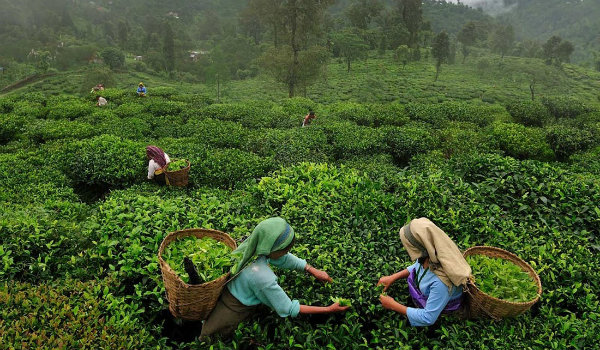
With 28% of the worlds total production, India is a leading producer of tea.
India ranks third among tea exporting countries in the world after Sri Lanka and China.
Assam accounts for about 53.2% of the total cropped area and contributes more than half of total production of tea in the country; West Bengal, and Tamil Nadu are the other leading tea producers.
There are three varieties of coffee − arabica, robusta, and liberica.
India generally grows superior quality of coffee i.e. arabica, which is in great demand in the International market
India produces only about 3.2% coffee of worlds total production and ranks 7th after Brazil, Vietnam, Colombia, Indonesia, Ethiopia, and Mexico.
Coffee in India is cultivated in the highlands of the Western Ghats in the states of Karnataka, Kerala, and Tamil Nadu.
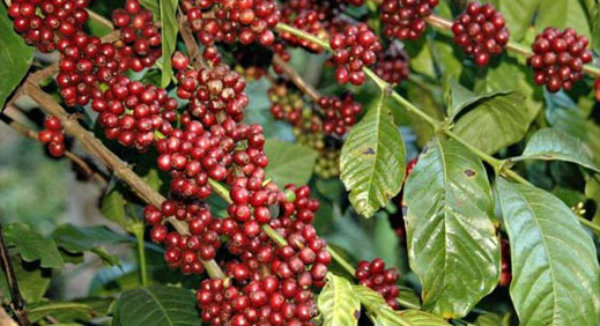
Karnataka alone contributes more than two-third to the total production of coffee in India.
New seed varieties of wheat (from Mexico) and rice (from Philippines) known as high yielding varieties (HYVs) were introduced during mid-1960s in India (Green Revolution).
Agricultural Problems
About 57% of the land is covered by crop cultivation in India; however, in the world, the corresponding share is only about 12%.
On the other hand, the land-human ratio in the country is only 0.31 ha, which is almost half of that of the world as a whole i.e. 0.59 ha.
-
However, major problems of the Indian agriculture system are −
Dependence on erratic monsoon;
Low productivity;
Constraints of financial resources and indebtedness;
Lack of proper land reforms;
Small farm size and fragmentation of landholdings;
Lack of commercialization; under-employment; and
Degradation of cultivable land.
Further, lack of development of rural infrastructure, withdrawal of subsidies and price support, and impediments in availing of the rural credits may lead to interregional and inter-personal disparities in rural areas.
Intensive Agricultural District Program (IADP) and Intensive Agricultural Area Program (IAAP) were launched to overcome the agricultural problems in India.
Planning Commission of India initiated agro-climatic planning in 1988 to induce regionally balanced agricultural development in the country.